edenwatcher
Well-known member
Not sure that (m)any get killed. They gradually disperse to breeding areas in Senegal and most are gone by January.
Rob
Rob
Not sure that (m)any get killed. They gradually disperse to breeding areas in Senegal and most are gone by January.
Rob

... doing the thing I like least abroad: going quickly through long grass where I can't see where I'm putting my feet or for that matter, on what!

And a bit more from the walk, plus on the road:
Namaqua Dove
Speckle-fronted Weaver X 2
Male Sahel Paradise Whydah
Plain Tiger
Hi John,
I was curious about this having been to Gambia many years ago and thought I'd try and nick an armchair tick, which I can't.
Sahel orientalis as opposed to Exclamatory interjecta, is supposed to have a pale, straw coloured nape per HBW?
HBW states for interjecta
'Breeding male has most of head black, nape dark brownish-red,'.....doesn't this description fit your bird better or is the other race of Sahel, aucupum similar?
This is what I'd expect Sahel to look like?
https://www.flickr.com/photos/9677773@N03/23312915204

As far as the description goes, no, I don't think it does. The nape was if anything orangey, dark brownish red is not the colour I would call it at all. I looked at HBW and the photos there seem quite variable and mine well within that. I imagine age and time of year cause some of the variation, let alone race.
John
The bird at the link I posted, has a nape which is the same colour as it's belly which is what I'd expect, not the rich colour that yours is but, as you say, there are images which appear at odds with this and I have to ask if they're correctly ID'd?
I just lifted the following from a Flicker post and it seems to confirm my suspicions that this is a fraught ID. I don't know this bloke but he's clearly switch on to the potential pitfalls of ID.
'Possible conflict about species, incidently. Among both the guidebooks and the guides. If I'm remembering correctly from the guides, the pic taken near Bansang Quarry, should be more likely that of the Sahel Paradise Whydah (Vidua orientalis). But the two birds photographed between Farifenni and Wassu might be the Exclamatory Paradise Whydah (Vidua interjecta).
Problem: in breeding plumage, the Sahel P-W (Vidua orientalis) is almost identical to the Exclamatory P-W (Vidua interjecta), expecting the Sahel P-W has slightly shorter tail steamers -- up to 24cm or almost twice the normal size of the bird at 12.5cm.
In contrast, the Exclamatory P-W (Vidua interjecta) typically has tail steamers greater than 27cm: distinctly although perhaps not dramatically over twice the length of the bird's normal 12.5cm size.
I confess that (1) I can't tell the difference in the three pics I have here. And (2) although Barlow and Wacher list the Exclamatory P-W (Vidua interjecta) for Senegambia as more common, Clements 6th lists only the "S-P Whydah" or "Northern Paradise Whydah" (Vidua orientalis).
Borrow and Demey are not much help either, as the range of both species overlap. The key difference in behavior: the Sahel Paradise Whydah (Vidua orientalis) parasites the Green-winged Pytilla and so mimics its call. The Exclamatory Paradise Whydah (Vidua interjecta) parisites the Red-winged (and possibly Yellow-winged) Pytilla.
Otherwise, the non-breeding male of Exclamatory Paradise Whydah (Vidua interjecta) has pinkish legs and a pale bill; female of the same, also pinkish legs. Whereas for the Sahel Paradise Whydah (Vidua orientalis), the non-breeding male and female have darker legs and bill.
Unless Martin, Buckeye, Cuckooroller or someone with more African bird expertise than myself sees it otherwise, I'm listing these all for now according to Clements 6th as members of Vidua orientalis, the Sahel or Northern Paradise Whydah. The tail streamers seem less than -- not greater than -- 2x the bird's body.
Hmmmmmmmmmmmmmmm, looks like rather than gaining a tick, I might have to lose one as I have no idea which I saw, other that that it was at Seleti which is just, in Senegal.
Many years ago when I was in Gambia for an extended period, Melba Finch/green-winged pytilia was either rare or rarely encountered. I saw one once when with Tim Wacher up country. So makes sense if sahel paradise whydah is rarer.

But presumably that wouldn't necessarily apply out of the breeding season? Remember Ebrima's presumption was that the birds had come down a little early.
In addition, thanks to the prompt of Andy's additional comments, I can confirm that both Ebrima and Steve (who has far more African experience than I have) both confirmed in answer to my question about why it was one, that the tail was not ("nothing like" was Steve's phrase) long enough for Exclamatory. Personally I will take structure over plumage any day of the week.
Every day a school day, anyway. :t:
John
Forgive my scepticism John but I remain far from convinced that it's so simple.
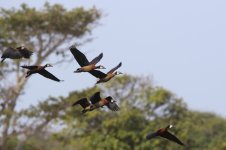
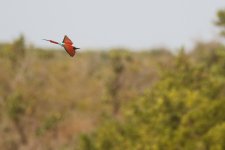
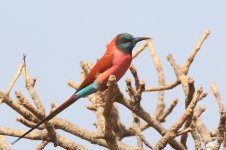
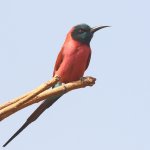
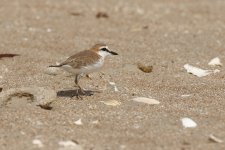

Northern Carmine Bee-eater X 3
:t::eek!:
Fantastic bird: truly mind-boggling!

